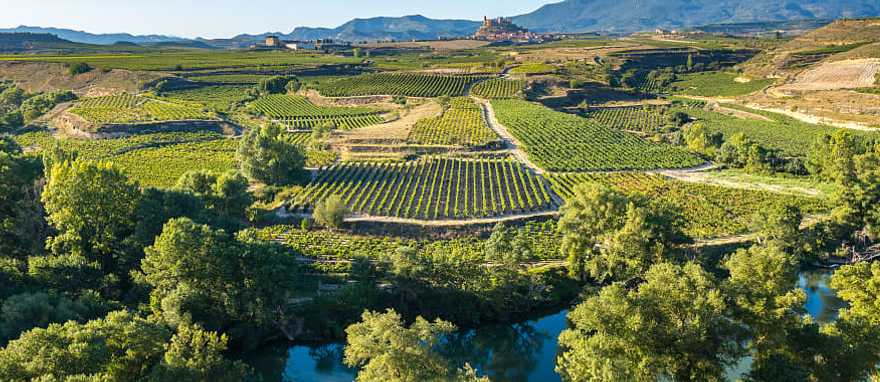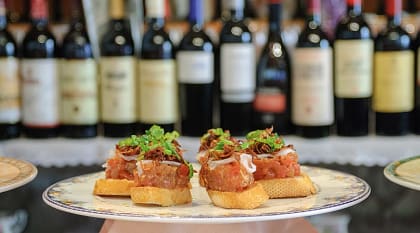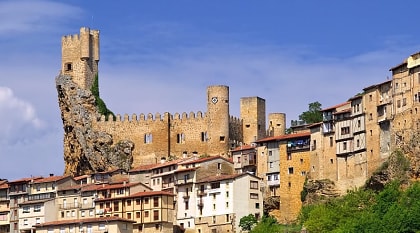Wonders of Spain Food & Wine Tour

What to expect on this itinerary
It will not just be what you taste so much as it will be where you taste it. Sparkling Cava while gazing over Penedes vines, Rioja Gran Reserva in a Laguardia cellar, exclusive Priorat wine at a hillside farmhouse, and the arid beauty of Ribero del Duero are all yours to enjoy. Handcrafted to explore Spain’s most important wine regions, this relaxed 10-day tour covers the places and people that define the wine. Three nights in Barcelona for Penedes and Priorat, two nights in Ribero del Duero, three in La Rioja, and then Madrid.
Customizable Itinerary
Barcelona – Wine Bars in Barri Gotic
Barcelona has an alluring atmosphere, even during the winter. You can sense that this is a city where people enjoy life and live it to its fullest. Touch down and transfer to Barri Gotic, a central pedestrianized area dotted with Roman remains and Gothic architecture. Out on the streets, you will feel the energy and the vibrancy of a bustling, coastal city. You will find wine bars tucked into millennia-old churches, plus boutique wine terraces for watching the people walk by. It will be at these wine bars where you start your exploration, your guide helping you get an overview of Spanish wine region styles, helping you get a feel of varietals and vintages.
What's Included:
Barcelona – Crisp, Sparkling Cavas Start You Off in Penedes
Barcelona – Deep, Luscious Reds in Priorat
Burgos – Velvety Tempranillo and a Stunning Medieval City
Burgos – Exploring Rural Ribero del Duero Country
Laguardia – Visiting Rioja Vineyards en Route to the Cellars
Laguardia – More Classic Rioja Experiences
Laguardia – A Day Trip of Experimental Flavors From the Navarre Valley
Madrid – Exploring New-World Styles in the Capital City
Madrid – Departure
Trip Highlights
- Enjoy the complete range of varietals and vintages as winemakers and cellar-masters dust off the old bottles
- Taste your way through the finest Spanish Cava with a day of tasting in the Penedes wine region
- Spend three nights in Laguardia, a charming La Rioja town with a labyrinthine wine cellar
- Discover Spain’s most revered red, the exclusive and hard to find wines of Priorat
- Visit the vineyards of Ribero del Duero, the big rival to La Rioja as Spain’s favorite wine region
- Be guided through the best wine bars in Barcelona and Madrid, places where you can taste from up and coming wine regions not visited on the tour
- Sample new-world experimental styles with a day in the Navarre Valley, including a stop in Pamplona
- Explore a vineyard alongside a winemaker, taste with cellar-masters and come to understand the subtleties that Spanish wine creates
Detailed Description
At first, Spanish wine dazzles with its diversity. While the grapes being used are relatively standard across the country, a Priorat is quite different from a Toro. When you explore more, there are more subtle differences, like when La Rioja and Ribero del Duero are compared through multiple vintages. Tempranillo is the dominant grape, but the cultivation methods contrast across the Spanish DO (denominacion de origen) regions. And like all good wine countries, it is the diversity of terroir that proves most memorable. This handcrafted tour visits Spain’s most important wine regions and has you tasting the differences. By connecting you to people and places, it helps you really understand Spanish wine, with the story told by those that define it.
Visit Spain, and you can visit vineyards, perhaps do a tasting, and certainly try wines in the bars. This tour is packed with private appointments at places normally closed to the public. You will taste with the winemakers and cellar-masters, and then tour the vineyards to see how and why the wine turns out differently. Unlike the bars, you will get to taste multiple vintages as winemakers dust off bottles from the cellar to open. Where you get to taste will also be memorable, be it the steep terraced hills of Priorat, the lush landscapes of Penedes, or the rustic charm of Ribero del Duero.
There are four overnight destinations, and most of your days are spent in wine country, stopping in villages and vineyards. You will stay in cities and towns, so there is plenty to see and do beyond just the wine. Although Spain has 11 DO regions and two DOCa regions, the highest category under Spanish wine regulations, this tour focuses on the most important while also a providing chance to explore upcoming, new-world-style wines as well. There will also be plenty of food en route with each region showcasing their culinary specialties, found everywhere from pintxos bars to fine-dining restaurants.
Base yourself in Barcelona for the first three nights, a vibrant city with all manner of world-class monuments to check out. Spend the first evening with your guide in Bari Gotic to explore the wine bars and tune your palette to the different regions. On day two, you will explore the heart of Penedes where crisp, sparkling wines are a good palette cleanser for the heavier reds that will come. Sample the aromatic Cava whites while looking over the vines, enjoy a Cava and food pairing, and then weave back to Barcelona, perhaps with a stop in Sitges. Priorat is a DOCa region and the focus of day three, producing fine exclusive red wines that demand good cellaring. They are boutique wines that can be hard to find outside Spain, so indulge at two wineries.
Fly to Burgos, a beautiful medieval city with a cathedral you won’t quite believe. Now you will be into the velvety Tempranillo wines that are synonymous with Spain, the Ribero del Duero the region now rivaling La Rioja as the rumors continue that it will soon receive DOC status. With two days at your disposal, you can relax and really get to know the medieval city, as well as visit four to five different wineries. Next, it will be La Rioja, and you will descend into Laguardia’s aromatic wine cellars and feast on an atmosphere where everything revolves around wine. You cannot rush things in La Rioja because nothing really happens to speed time, your languid morning giving way to lunchtime wine, and then more wine.
In the next two days, you will visit a selection of vineyards ranging from world-famous producers to small farms that preserve handpicked and handcrafted methods. The next day, you will head to Pamplona, an old city of towering walls and cute squares. The city is famous for the Running of the Bulls and in the heart of the Navarre Valley, where experimental vineyards and part of a wave of new-world wine in old-world wine country. End your trip in Madrid, where sightseeing meets with decorous wine bars, and you can taste those regions that have not been featured thus far – Toro is just one to watch out for. Being the capital city, Madrid also provides good flight connections as your ten days with Spanish wine comes to an end. Throughout the tour, guides will assist in shipping your purchases back home. Spain is a region unlike any other; learn more by seeing how our partner Spain tour operators can personalize the experience for you.
Starting Price
$3,900 per person (excluding international flights)
Your Zicasso trip is fully customizable, and this sample itinerary is a starting place for your travel plans. Actual costs are dynamic, and your selection of accommodations and activities, your season of travel, and other such variables will bring this budget guideline up or down. Throughout your planning experience with your Zicasso specialist, your itinerary is designed around your budget. You can book your trip when you are satisfied with every detail. Planning your trip with a Zicasso travel specialist is a free service.
What's Included
- Accommodations
- In-country transportation
- Some or all activities and tours
- Expert trip planning
- 24x7 support during your trip
Your final trip cost will vary based on your selected accommodations, activities, meals, and other trip elements that you opt to include.
Verified Traveler Reviews
Based on 2710 reviews
We received excellent customer service from Zicasso's travel company.
See more
We loved our trip to Spain and Portugal! We enjoyed each of our private tours with our tour guides in the various cities we experienced. They went above and beyond to share their knowledge of the planned sites, plus they added in individual unique sites and information along our walking route.
Zicasso’s tour company took all of our requested activities, venues, and interests to customize a trip that fit us well. They were in communication with us during our trip when a planned site was not available due to construction. Our tour guide provided us with other possible replacement options and let us choose what was of interest to us rather than them making the decision.
We tremendously enjoyed all of the cities, Madrid, Toledo, Granada, and Seville in Spain and Lisbon and Porto in Portugal. Our trip went smoothly and the activities were scheduled at a good pace for us! An extra bonus for us was seeing King Felipe VI by being in the right place at the right time near the opera house in Madrid while we were on our walking tour. We highly recommend Zicasso and the tour company.
See more
We loved every minute of our trip and were very impressed with the attention to every detail. Each guide was wonderful, extremely well-informed, and fun!
See more
A few bumps were encountered along the way, but we were happy with the resolution and the overall experience.
See more
This trip was spectacular and Zicasso’s travel agent was very accommodating and helpful. He made our trip go from good to amazing!!
See more
Zicasso’s travel specialist and her team were fantastic. They were very responsive and quick to make changes when our arrival flight was delayed a day. The experiences were tremendous and the meeting times and contact points with various guides and drivers in several cities were well organized and seamless.
See more





